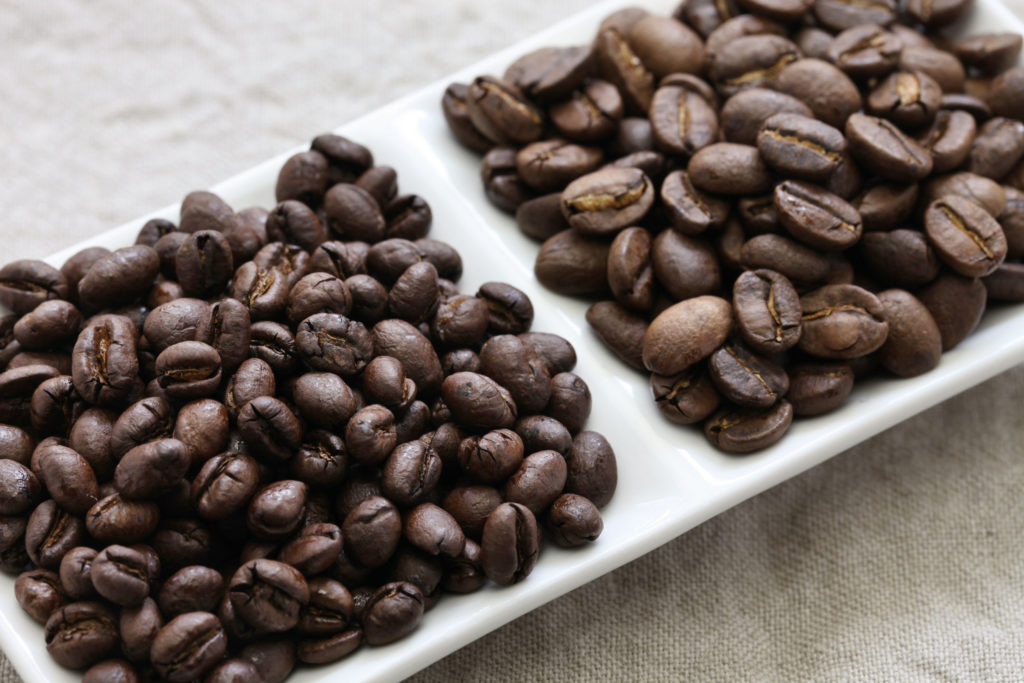Many factors go into how your morning cup of coffee tastes – where it’s grown, how it’s processed, how it’s roasted, how it’s brewed, etc. But it all starts with the type of bean. But there are other, often overlooked factors as well, including mutations. The Peaberry (also commonly known as “caracol,” the Spanish word for snail) is one of the most interesting and most prized of these mutations.
Before delving into what makes the Peaberry so different, let’s look first at some of the basic categories of coffee bean. First of all, it’s important to know that there are two main species of beans – Arabica and Robusta. Arabica beans are generally considered to be of higher quality, and are what you are most likely to get in higher end coffees, from chains like Starbucks and Peet’s to so-called “third wave” specialty coffee roasters. In fact, most coffees boast on their packaging and marketing that they use exclusively arabica beans. While they account for the majority of coffee consumed in the world, that wasn’t always the case, and the supermarket coffee many of us grew up on (the type in the can) was generally Robusta.
Robusta beans are easier to grow, and tend to be both stronger and more bitter in flavor. They also have around double the caffeine content of Arabica beans. While they’re generally considered to be inferior to Arabica beans, there are many that are quite excellent, and in fact can be very effective in espresso, or for people who prefer very strong coffee. Quite a number of first-rate blends will actually combine Arabica and Robusta beans.
Beyond the main species, there are many individual varietals, each with their own qualities – from Bourbon, to Typica, to Geisha and Catuai. You’ll often see these names in the descriptive summaries of high-end coffees.
And then there are the mutations. To explain what the Peaberry mutation is, you must understand what the coffee bean really is – it’s the stone inside the coffee cherry, or the fruit of the coffee plant. Normally, coffee cherries have two beans inside. Those beans are oval and flat. In the Peaberry mutation, one of the beans fails to grow, and the one bean that does is smaller and rounder. This mutation happens in both Robusta and Arabica beans, in all growing regions, and across all varietals. It occurs in between 5 and 10% of harvested coffee cherries.
(Peaberry beans are on the left, and regular beans are on the right)
From the outside, cherries with Peaberry beans look no different than other cherries. It isn’t until the cherries have been harvested and dried that the Peaberries can be separated out from the larger beans. This process is done by hand, which tends to make Peaberry brews more expensive, due to the extra labor.
In addition to being smaller and rounder than regular beans, Peaberries are also denser. All of these characteristics affect the roasting process. The Peaberries tend to roast more evenly, and require different adjustments to heat level and roasting time. Specifically, because of the density of these beans, doing a slow, steady, careful roast is required in order to ensure that the flavors fully develop throughout these dense beans. All of this obviously results in some specific differences in flavor profile.
While coffees from different regions and different varieties, and even different seasons, have different, distinct flavor profiles, it is generally understood that Peaberry beans tend to be sweeter and brighter tasting than others.
For a limited time, Pure Coffee Club customers can experience this rare bean. This particular lot comes from Kenya, and is available through our Explorer Series. Sweet and rich, the prominent tasting notes are peach and lemon tart, with a strong finish of dark chocolate as it cools. If you’re already an Explorer Series subscriber, this will come automatically while it’s in stock. If you’d like to experience this exceptional brew, and at the same time start your exploration of the world’s great single origin coffees, sign up for our Explorer Series here.

